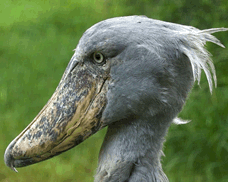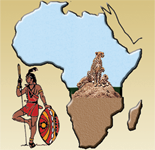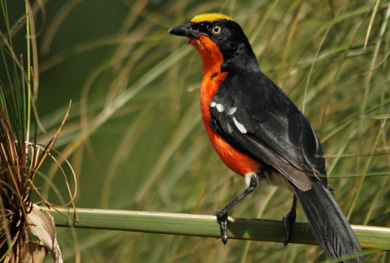18 Days Uganda Birding Safari
fromBest Bird & Safari Guides
Impenetrable Forest at Bwindi
Accommodation Options:
Buhoma tented camp
Engagi Camp
Paara Safari Lodge
Mara Sarova Tented Camp
-
Reviews 0 Reviews0/5
-
Vacation Style Holiday Type
-
Activity Level
-
18 Days Uganda Birding Safari
 Uganda is one of the richest countries in Africa for birds, with over a thousand species being recorded. This diversity results from Uganda’s position on the Equator at the crossroads of the plains of East Africa and the rain forests which dominate much of West Africa. It is a country of varied and beautiful landscapes with forests, natural lakes and the source of the Nile. Our tour takes in the premier regions for birds including the Impenetrable Forest at Bwindi and the rich forest habitats of Semliki. This trip to ‘The Pearl of Africa’ is bound to produce a long bird list as well as close sightings of primates and mammals. Interesting species recorded on previous visits include the impressive Shoebill, Congo Serpent Eagle, White-spotted Flufftail, Dwarf Kingfisher, Red-billed Dwarf Hornbill, Black Bee-eater, Papyrus Gonolek, Doherty’s Bush-shrike and Purple-breasted Sunbird.
Uganda is one of the richest countries in Africa for birds, with over a thousand species being recorded. This diversity results from Uganda’s position on the Equator at the crossroads of the plains of East Africa and the rain forests which dominate much of West Africa. It is a country of varied and beautiful landscapes with forests, natural lakes and the source of the Nile. Our tour takes in the premier regions for birds including the Impenetrable Forest at Bwindi and the rich forest habitats of Semliki. This trip to ‘The Pearl of Africa’ is bound to produce a long bird list as well as close sightings of primates and mammals. Interesting species recorded on previous visits include the impressive Shoebill, Congo Serpent Eagle, White-spotted Flufftail, Dwarf Kingfisher, Red-billed Dwarf Hornbill, Black Bee-eater, Papyrus Gonolek, Doherty’s Bush-shrike and Purple-breasted Sunbird.
Days 1-2: Entebe
Fly to Uganda with arrival on the following morning, transfer to Entebbe for an overnight stay. After resting and freshening up we visit Entebbe Botanical Gardens adjacent to Lake Victoria. The larger trees attract Grey Woodpecker, Great Blue and Ross’s Turacos, Black and White Casqued Hornbill, Red-bellied Paradise Flycatcher, Black-necked and Spectacled Weavers and Eastern Black headed Oriole. Riverine trees attract Orange-tufted, Green-throated and Red chested Sunbirds and a range of weavers including Slender-billed, Orange, Northern Brown-throated and Yellow-backed.
Day 3: Mbamba village
Today we visit Mbamba village and its adjacent swamp. The entrance road winds its way through areas of secondary forest and agricultural land attracting Madagascar Bee-eater, Redheaded Lovebird, Black-necked and Weyn’s Weavers. We enter Lake Victoria in hand-paddled boats, exploring a maze of channels and mudflats for Shoebill, African Marsh Harrier, Allen’s Gallinule, Lesser Jacana, Blue-breasted Bee-eater, Winding Cisticola and White-winged Warbler. Later in the day, we transfer to Mbarara for a two-night stay.
Day 4: Lake Mburo National Park
A day exploring Lake Mburo National Park, an area of wetlands and acacia forests. Grassy fields scattered with acacia trees lure Senegal Lapwing, Bare-faced Go-away-bird, Eastern Grey Plantain-eater, and White-winged Tit. We take boat trip on the lake for Whitebacked Night Heron and African Finfoot. In the park itself, an exploration of tracks and reed-lined swamps may produce Nubian Woodpecker, Yellow-breasted Apalis, Spot-flanked and Black-collared Barbets. At Nshara Gate, a large seasonal marshland has Rufous-bellied Heron, African Water Rail and Three-banded Plover. Drier areas attract Crested Francolin, Red-faced, and the rare, Longtailed Cisticola, Yellow-throated Longclaw and Golden-breasted Bunting.
Day 5: Bwindi Impenetrable National Park
Travel to Bwindi Impenetrable National Park straddling the border with Congo. Our journey takes us to Kabale and over highlands reaching almost 2500 metres. Specialties include Augur Buzzard, White-headed Woodhoopoe, Black crowned Waxbill, Thick-billed Seedeater and Chubb’s Cisticola. We eventually reach Bwindi, a huge montane forest, for a two-night stay at Buhoma tented camp.
Day 6: Bwindi Impenetrable Forest
Bwindi Impenetrable Forest is exceptionally rich in forest species restricted to the Albertine Rift covering Uganda, Rwanda and Congo. Walking along forest trails is a wonderful natural experience with hundreds of colourful butterflies and areas of streams and tumbling waterfalls. Bwindi offers some of the best forest birding in Africa. The campgrounds before the main track attract Black Sawwing, Petit’s Cuckoo-shrike, Vanga Flycatcher, Mackinnon’s Fiscal, Luhder’s Bush-shrike, Black-billed Weaver, Variable Sunbird and Grey-crowned Negrofinch. On the main track, we enter the forest with its huge trees and lichen-lined trunks a reliable area for White-tailed and Red-throated Alethe, Black-faced Rufous Warbler and Yellow-eyed Black Flycatcher. Other species recorded on recent visits have included Crested Guineafowl, Black Bee-eater, Elliot’s Woodpecker, Yellow throated, Yellow-rumped and Speckled Tinkerbirds, Grey-throated and Yellow spotted Barbets, Equatorial Akalat, White-tailed Crested-flycatcher, Sooty Flycatcher, Stuhlmann’s and Waller’s Starlings, Slender-billed, Plain, Little, Shelley’s and Yellow Whiskered and Red-tailed Greenbuls, Green-throated Sunbird and Brown-capped Weaver.
Day 7: Ruhija
After breakfast we transfer to Ruhija which is situated at an elevation of 2300m. The Neck is an important habitat for birds and we may see Grey-headed and Little Green Sunbirds, Dusky Blue Flycatcher, Pink-footed Puffback and the poorly known Lagden’s Bushshrike. The river has Mountain Wagtail and Cassin’s Flycatchers. As we ascend in height we should find Augur Buzzard, Olive Pigeon, Thick-billed Honeyguide, Chestnut throated and Rwenzori Apalis’s, Doherty’s Bush-shrike, Mountain Oriole, Regal and Blue-headed Sunbirds. Two nights at Engagi Camp.
Day 8: Ruhija
Ruhija has many important birding areas. During our stay we intend to explore several trails and habitats. Along the main track we may find Handsome Francolin, Mountain Greenbul, White-browed Crombec, African Hill Babbler, Collared Apalis, Banded Prinia and the scarce Grauer’s Warbler. In areas of grasses and thickets, we search for Shelley’s Crimsonwing, Mountain Illadopsis, Archer’s Robin Chat, Cinnamon Bracken and Mountain Yellow Warblers.
Day 9: Queen Elizabeth National Park
Transfer to Queen Elizabeth National Park, birding en route. Our journey takes us through the southern sector of the park.At Ishasha, a remote camp ground, we look for Black Cuckoo-shrike, Yellowbill, and African Firefinch. The road passes (seasonal) pools with Red-billed Duck, Hottentot Teal and Greater Painted-snipe. We eventually reach the Kazinga Channel, linking Lake George and Lake Edward, and our base at Mweya Safari Lodge, an idyllic location set in its own grounds. Two night stay at Mweya.
Day 10: Queen Elizabeth National Park
We have a full day exploring Queen Elizabeth National Park and the northern sector, an area of savanna, bush,river and lake habitats. The hotel gardens have Grey-headed Kingfisher, Swamp Flycatcher, Black-headed Gonolek, Grey-capped Warbler and Slender-billed Weaver. We take an early morning game drive towards the Kasenyi Track. Along the road, we should find Scaly Francolin, Crowned Lapwing, Harlequin Quail and Common Button-quail. Larks are numerous and comprise Rufous-naped, Flappet and the localised White-tailed Lark. Raptors we aim to locate include Lappet-faced and White-backed Vultures, Martial Eagle, Banded Snake Eagle and Bateleur. Wet grassland may hold Broadtailed and African Moustached Warblers, Trilling and Croaking Cisticolas, Marsh Tchagra, Fawn-breasted and Crimsonrumped Waxbills. Acacia trees are home to Black-headed Batis, Sulphur-breasted Bushshrike and Red-shouldered Cuckooshrikes. In the afternoon, we embark on a boat trip down the Kazinga Channel. This is an incredible area for waterbirds, giving us close views of Saddle-billed Stork, African Spoonbill, Water Thick-knee and African Skimmer.
Days 11-13: Fort Portal
Travel to Fort Portal and on to Bundibugyo for a two-night stay. The town is close to Semliki National Park. Trails running through humid forests are productive for White-bellied Kingfisher,Black-casqued, Black Dwarf and Redbilled Dwarf Hornbills, Forest Robin, African Piculet, Red-rumped Tinkerbird, Brown-chested Alethe, Yellow-throated Nicator, Xavier’s Greenbul and Chestnut Wattle-eye. Rarer species we hope to find include Hartlaub’s Duck, Long-tailed Hawk, Black-collared Lovebird, Yellowthroated Cuckoo, Spotted and Lyre-tailed Honeyguides, Rufous-sided Broadbill, Blue-headed Crested Flycatcher and Grant’s Bluebill. Semliki also has habitats of grassland dotted with scrub and palms attracting another wide range of birds. On the afternoon of Day 13 we transfer to Fort Portal for the night.
Day 14:
After breakfast, we head towards Masindi along a maintained dirt road. An agricultural area close to a village offers us Speckle-breasted Woodpecker, Lesser Honeyguide, Brown-crowned and Blackheaded Tchagras, Green-throated and Purple-banded Sunbirds. As we approach Masindi, forest patches may produce Grey Woodpecker, White Helmetshrike and African Grey Parrot. Two nights in Masindi.
Day 15:
A pre-dawn start in order to arrive early at Budongo Forest and the Royal Mile, a pristine forest reserve. Before entering the forest, we should see Whitethighed Hornbill. Our main interest is locating forest species either on the forest floor or in the giant trees. We have good chances of locating Chocolate-backed and Dwarf Kingfishers, Brown-eared and Yellow-crested Woodpeckers, Grey Apalis, Forest Robin, Red-capped Robinchat, Red-crested Malimbe, Grey Longbill, Rufous-crowned Eremomela, Greenbacked Twinspot. As we pass through the forest, we find colonies of Yellow-backed Weaver.
Day 16: Murchison
Travel to Murchison where we drop down into the Rift Valley with views of Lake Albert and the Congo. The habitat changes and we may locate Brown Snake Eagle, White-bellied Go-away-bird, Foxy Cisticola, Red-winged Grey Warbler and Brown-throated Wattle-eye. At Paraa, we take a ferry across the Victoria Nile for a two-night stay at Paara Safari Lodge.
Day 17: Victoria and Albert Nile
Today we cruise up the Victoria and Albert Nile towards Lake Albert itself, a haven for waterbirds. We should record Goliath Heron, Long-toed Lapwing, Senegal Thick-knee and Blue-breasted Bee-eaters. Riverside banks and trees attract Northern Carmine and Swallow tailed Bee-eaters. Murchison, with its abundant bird and mammal life, is our afternoon safari. Travelling along dirt tracks provides us with Crested and Heuglin’s Francolins, Black-bellied Bustards and Flappet Lark, whilst the taller trees attract Striped Kingfisher, White-breasted Cuckoo-shrike, Bronze tailed Starling and Speckle-fronted Weaver. Red-necked Falcons and parties of wandering Abyssinian Ground Hornbills prefer areas of palms. Stunted bushes have the attractive Silverbird and grassy areas near the river host Grey-crowned Crane, Spotted Mourning Thrush and Bar breasted Firefinches.
Day 18:Travel to Kampala and on to Entebbe.
- Ground Price: $6,551 Single room: $684
- *Air Fare: Not included
- Tour Price Entebbe/Entebbe: $6551 Deposit: $1200
- This holiday is fully inclusive of accommodation and meals, transport, boat trips, entrance and permit fees, guidance, tips and taxes.
Not included:
-
- drinks,
- insurance,
- items of a personal nature,
- a visa to enter Uganda.
- If you wish to track gorillas, the current permit costs US$900.00 including entrance fees and
- guidance. Please advise us when you book if you wish to take this option.
- Permits are limited and should be purchased six months in advance of your visit.

